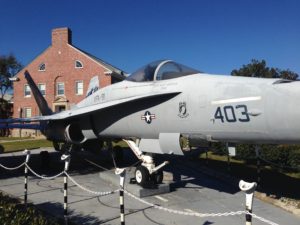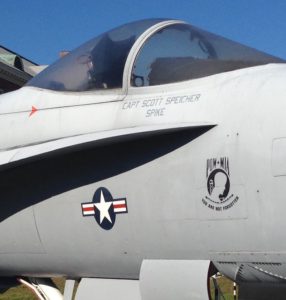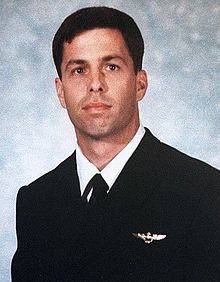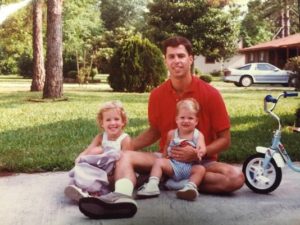Flying With Spike
Next to the academic building at Naval Aviation Schools Command in Pensacola is a F/A-18 Hornet painted in the livery of Strike-Fighter Squadron 81, the Sunliners. All who begin their naval aviation adventure begin it in Pensacola, and this building and the jet parked next to it are familiar landmarks. There is a name painted under the canopy, a high honor for such an iconic static display aircraft, one that is viewed by hundreds each month as they take the first steps in the long journey to wings. The name is a challenge to them, a name carefully chosen of one to emulate. Be like this name, the stenciling suggests.
CAPT SCOTT SPEICHER
It is doubtful that any of today’s students were alive when this name was in the news over 27 years ago, but certainly some are aware of this man and his actions in combat. To Americans of a certain age – a nice way of saying much older – this name may jog a memory. Where have I heard that name before?
To me, and many readers of this blog, the callsign under the stenciling conveys warm feelings of friendship and shared good times, of loyal devotion to duty, of trust, and courage. And an infectious smile.
SPIKE
I first met Spike in 1986 at Cecil Field when, due to hangar overcrowding, our A-7 squadrons were shoe-horned together for a period of time. Spike was in VA-105, a squadron that years later would hold special meaning for me. What a great group the Gunslingers had; Shoe, Mongo, Duck, Lady, Bone, Bud-Man, Frailes, Roots. We had fun hanging out in the cramped ready room, and it was evident all the guys had high regard for Spike.
Spike was a year or two senior to me, and before I could become a shore-duty instructor in the F/A-18 I had to first learn the jet. Spike was one of my instructors in the Gladiators. My logbook records that our first “flight” together was March, 12, 1988, each of us in a Hornet conducting 1v1 Basic Fighter Maneuvering training over the Atlantic. I do not have a memory of this hop, but later that month my class went to Fallon for Air-to-Ground training and Spike was one of the instructors. It was on this det we got to know each other better as squadronmates. I’m sure he led formations I was part of, and I probably bought him a beer or two at the Silver State O-Club as penance for small in-flight infractions
With the airline good-life beckoning, junior aviators were resigning from the Navy as fast as they could. Back at Cecil the JO’s were herded into the ready room for a meeting with the Wing Commodore. Like any good leader he wanted to know what was on our minds and what could be done to keep us in uniform. He got an earful, and, exasperated, he asked, “Is anyone going to stay in?” In a room with Frailes who would one day command a carrier and wear stars, with Irish who rose to CAG, with Kid who 15 years later commanded the Gladiators, and others like me who stayed for careers, only one lieutenant ignored the peer pressure and raised his hand: Scott Speicher.
That August I was hanging around the ready room and Spike had an open back seat for a Fighter Weps hop he was instructing. I asked to jump in and he said sure. The set up was Spike leading a student in another Hornet against two A-4 “bandits.” I’m sure we had an enjoyable chat over the cockpit ICS as we led the student out to sea south of Ponte Vedra. However, once over the Atlantic it was all business. With a 40 mile split both formations came at each other as the Hornets worked their radars and communicated what they were seeing to each other on the radio. This is intense, fast, difficult, and at the merge damn dangerous. It is fun to be sure, but professional reputations are on the line and all of it will be debriefed in detail. Spike had to fly our jet and in a sense that of the student he was instructing. All I had to do was observe and keep a lookout. I think it was on this hop we were coming down the back side of a loop – we were inverted! – about 16,000 feet and a single red party balloon floated by our left wing, both of us incredulous that it was “out here” at least 30 miles east of St. Augustine.
The following is a vivid memory.
We were egressing west after an engagement, unloading for airspeed and with our wingman in sight. I saw an A-4 about two miles at our three-o’clock going to four and nose-off. I keyed the ICS.
“Tally one A-4 three-o’clock, two miles!” As soon as the words came out of my mouth I regretted them.
Spike snapped the jet right and into the “threat.” At once he saw the Skyhawk was no factor and yanked it back to the left to resume. “That guy’s no threat!” he scolded me with an edge and made it clear that future bad calls from me were not appreciated. Spike was easygoing and relaxed, but in this environment he was a fierce competitor first, even in this canned training scenario.
A minute later all was forgiven and forgotten, replaced with the exhilaration of flying a Hornet and enjoying Florida’s First Coast float under us on the way home. He led us into the break and let me fly a landing from the backseat. What a great time. They were all great times.
Though Spike was taller and better built, we resembled each other. One day as he picked up his daughter at the Orange Park preschool, my 2-year-old toddled over to him with outstretched arms thinking it was time to go. Another time I was summoned for a fitness report debrief. The skipper placed the paper in front of me and I read it. After I finished I said, “Skipper, this is a great fitness report. Unfortunately for me I’m not Scott Speicher.” He said something like “Doh!” and gave me my fitrep, which was more like what I was expecting.
Needling is part of squadron life. With my brother arriving at the airport in three hours, I led a division gun hop. In a hurry, I left the power up and “cruised” the formation at .93 Mach all the way out to the area off Amelia Island with Spike and the others hanging on. We shot the bullets, joined up, and hauled for home, also at .93. Spike laughed at me in the debrief as the lead of the shortest air-to-air gun hop he’d ever flown. I met my brother on time.
Spike left for his department head tour in VFA-81, and I saw him shortly before Saratoga deployed. He was genuine, and when he said let’s get together after the cruise, he meant it. In August of 1990 our world changed, and in the ensuing months many of my friends deployed to the Red Sea and Arabian Gulf. My ship didn’t go…I watched Desert Storm on TV…but steeled myself for losses. We didn’t know what to expect from a combat-experienced Iraqi Air Force in a new and unproven environment.
We received a call the Spike was missing, and that morning SECDEF himself declared him KIA. We were stunned. Not Spike. A month later we were stunned again. Not BJ.
The years rolled on, and rumors surfaced that things did not happen the way we were told that night. Spike ejected, we found out, with evidence he was alive on the ground.
Twelve years later Baghdad fell. Then at the Pentagon, I was told that finding Saddam was job one, with finding Spike a close #2.
Spike didn’t come home, and his story has been told and will be told better in time, but Spike was a shipmate in the truest sense of the word. An uncompromising warrior, those of us who knew him knew him as a devoted husband and father, a devout Christian who lived his faith, a superstar athlete, a model officer and superb aviator, a fun guy to be around…a great guy. There are a lot of great guys out there, but he really was.
Yes, the years roll on. It doesn’t happen often anymore, but being of a certain age there are occasions I am asked if I knew Spike. Yes, I smile, and tell them that he was one of the greatest guys I ever served with.




11 Comments